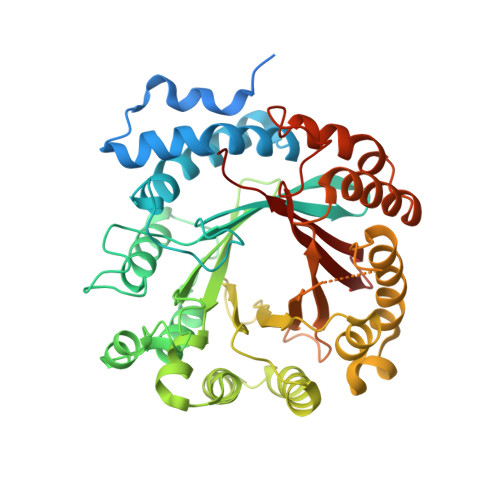Data Science-Driven Analysis of Substrate-Permissive Diketopiperazine Reverse Prenyltransferase NotF: Applications in Protein Engineering and Cascade Biocatalytic Synthesis of (-)-Eurotiumin A.
Kelly, S.P., Shende, V.V., Flynn, A.R., Dan, Q., Ye, Y., Smith, J.L., Tsukamoto, S., Sigman, M.S., Sherman, D.H.(2022) J Am Chem Soc 144: 19326-19336
- PubMed: 36223664
- DOI: https://doi.org/10.1021/jacs.2c06631
- Primary Citation of Related Structures:
6VY9, 6VYA - PubMed Abstract:
Prenyltransfer is an early-stage carbon-hydrogen bond (C-H) functionalization prevalent in the biosynthesis of a diverse array of biologically active bacterial, fungal, plant, and metazoan diketopiperazine (DKP) alkaloids. Toward the development of a unified strategy for biocatalytic construction of prenylated DKP indole alkaloids, we sought to identify and characterize a substrate-permissive C2 reverse prenyltransferase (PT). As the first tailoring event within the biosynthesis of cytotoxic notoamide metabolites, PT NotF catalyzes C2 reverse prenyltransfer of brevianamide F. Solving a crystal structure of NotF (in complex with native substrate and prenyl donor mimic dimethylallyl S-thiolodiphosphate (DMSPP)) revealed a large, solvent-exposed active site, intimating NotF may possess a significantly broad substrate scope. To assess the substrate selectivity of NotF, we synthesized a panel of 30 sterically and electronically differentiated tryptophanyl DKPs, the majority of which were selectively prenylated by NotF in synthetically useful conversions (2 to >99%). Quantitative representation of this substrate library and development of a descriptive statistical model provided insight into the molecular origins of NotF's substrate promiscuity. This approach enabled the identification of key substrate descriptors (electrophilicity, size, and flexibility) that govern the rate of NotF-catalyzed prenyltransfer, and the development of an "induced fit docking (IFD)-guided" engineering strategy for improved turnover of our largest substrates. We further demonstrated the utility of NotF in tandem with oxidative cyclization using flavin monooxygenase, BvnB. This one-pot, in vitro biocatalytic cascade enabled the first chemoenzymatic synthesis of the marine fungal natural product, (-)-eurotiumin A, in three steps and 60% overall yield.
- Department of Chemistry, University of Utah, Salt Lake City, Utah 84112, United States.
Organizational Affiliation:
















